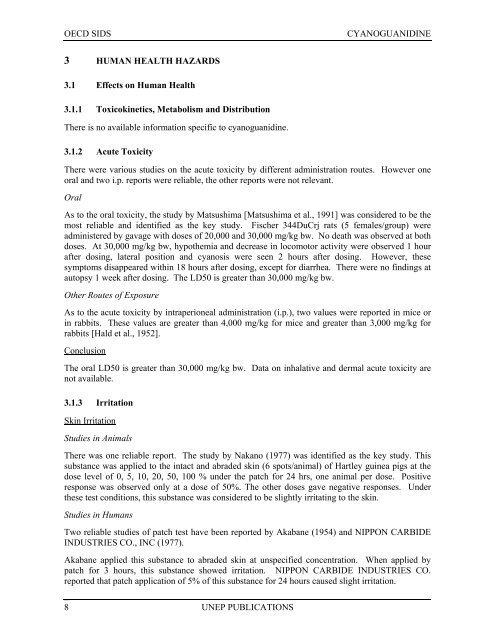Cyanoguanidine CAS N°: 461-58-5
Cyanoguanidine CAS N°: 461-58-5
Cyanoguanidine CAS N°: 461-58-5
You also want an ePaper? Increase the reach of your titles
YUMPU automatically turns print PDFs into web optimized ePapers that Google loves.
OECD SIDS<br />
CYANOGUANIDINE<br />
3 HUMAN HEALTH HAZARDS<br />
3.1 Effects on Human Health<br />
3.1.1 Toxicokinetics, Metabolism and Distribution<br />
There is no available information specific to cyanoguanidine.<br />
3.1.2 Acute Toxicity<br />
There were various studies on the acute toxicity by different administration routes. However one<br />
oral and two i.p. reports were reliable, the other reports were not relevant.<br />
Oral<br />
As to the oral toxicity, the study by Matsushima [Matsushima et al., 1991] was considered to be the<br />
most reliable and identified as the key study. Fischer 344DuCrj rats (5 females/group) were<br />
administered by gavage with doses of 20,000 and 30,000 mg/kg bw. No death was observed at both<br />
doses. At 30,000 mg/kg bw, hypothemia and decrease in locomotor activity were observed 1 hour<br />
after dosing, lateral position and cyanosis were seen 2 hours after dosing. However, these<br />
symptoms disappeared within 18 hours after dosing, except for diarrhea. There were no findings at<br />
autopsy 1 week after dosing. The LD50 is greater than 30,000 mg/kg bw.<br />
Other Routes of Exposure<br />
As to the acute toxicity by intraperioneal administration (i.p.), two values were reported in mice or<br />
in rabbits. These values are greater than 4,000 mg/kg for mice and greater than 3,000 mg/kg for<br />
rabbits [Hald et al., 1952].<br />
Conclusion<br />
The oral LD50 is greater than 30,000 mg/kg bw. Data on inhalative and dermal acute toxicity are<br />
not available.<br />
3.1.3 Irritation<br />
Skin Irritation<br />
Studies in Animals<br />
There was one reliable report. The study by Nakano (1977) was identified as the key study. This<br />
substance was applied to the intact and abraded skin (6 spots/animal) of Hartley guinea pigs at the<br />
dose level of 0, 5, 10, 20, 50, 100 % under the patch for 24 hrs, one animal per dose. Positive<br />
response was observed only at a dose of 50%. The other doses gave negative responses. Under<br />
these test conditions, this substance was considered to be slightly irritating to the skin.<br />
Studies in Humans<br />
Two reliable studies of patch test have been reported by Akabane (1954) and NIPPON CARBIDE<br />
INDUSTRIES CO., INC (1977).<br />
Akabane applied this substance to abraded skin at unspecified concentration. When applied by<br />
patch for 3 hours, this substance showed irritation. NIPPON CARBIDE INDUSTRIES CO.<br />
reported that patch application of 5% of this substance for 24 hours caused slight irritation.<br />
8<br />
UNEP PUBLICATIONS
















